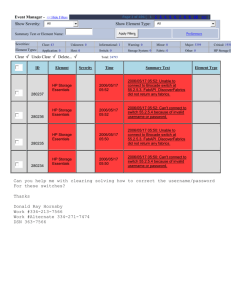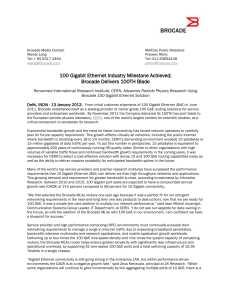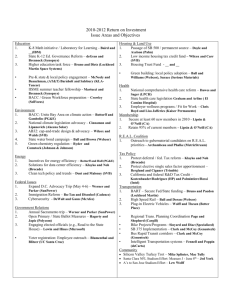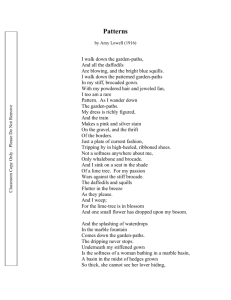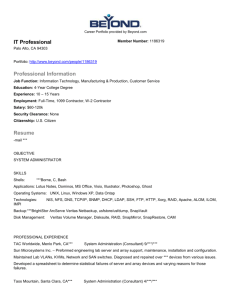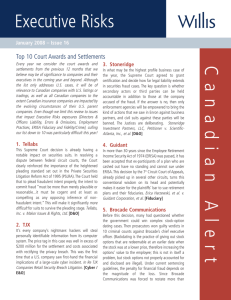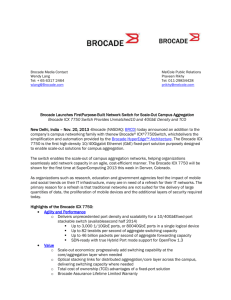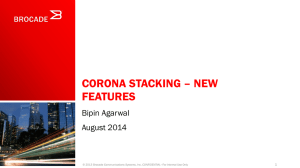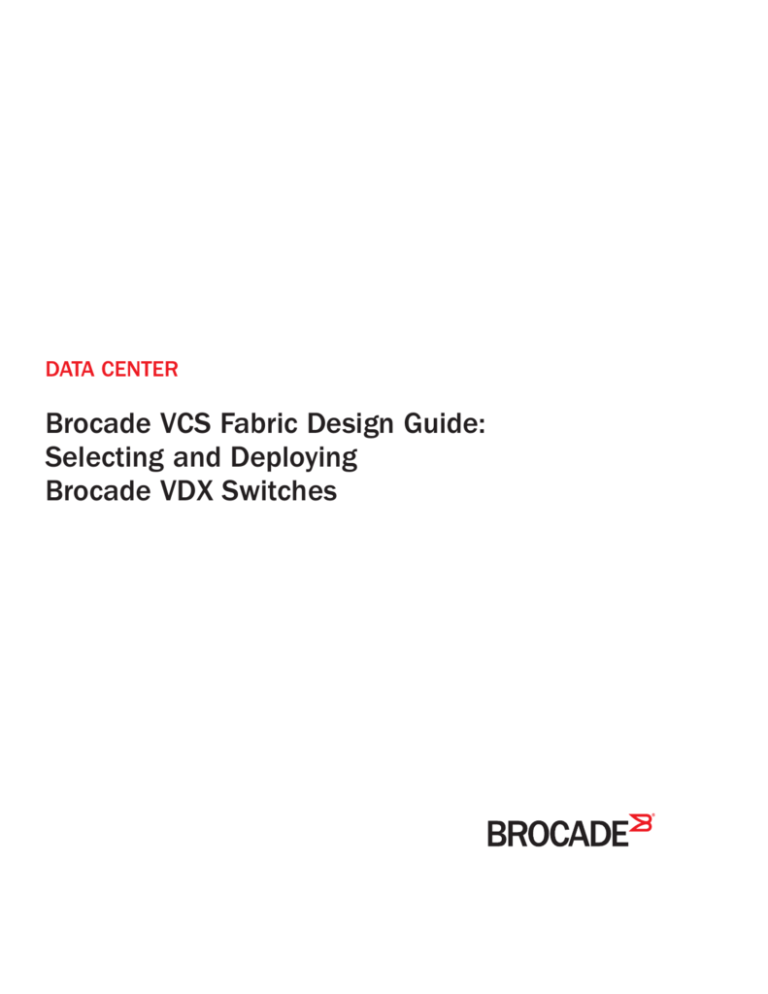
DATA CENTER
Brocade VCS Fabric Design Guide:
Selecting and Deploying
Brocade VDX Switches
DATA CENTER
DESIGN GUIDE
CONTENTS
Evolving the Network with Ethernet Fabrics .........................................................................................................................3
Brocade VCS Fabrics and VDX Switches................................................................................................................................3
Scalable Brocade VCS Fabrics................................................................................................................ 4
A Choice of Brocade VDX Switches......................................................................................................... 5
Flexible Brocade VCS Fabric Building Blocks for Easy Migration................................................................ 6
Switch Considerations..............................................................................................................................................................7
Brocade VDX and 3rd Party Switch Compatibility................................................................................................................8
Example Brocade VCS Fabric Topologies...............................................................................................................................9
Homogeneous Fixed-Port Switch Design.................................................................................................. 9
Homogeneous Modular Chassis Switch Design....................................................................................... 9
Mixed Switch Fabric Design.................................................................................................................. 10
Multi-fabric Designs............................................................................................................................ 12
Deploying the Brocade VDX 8770 and VCS Fabrics at the Classic Aggregation Layer ............................... 12
Brocade Data Center Services............................................................................................................................................. 14
Conclusion............................................................................................................................................................................... 14
Brocade VCS Fabric Design Guide: Selecting and Deploying Brocade VDX Switches
2 of 14
DATA CENTER
DESIGN GUIDE
EVOLVING THE NETWORK WITH ETHERNET FABRICS
New technologies and applications are driving constant change in organizations both large and small, and
nowhere are the effects felt more keenly than in the network. Large-scale server virtualization is generating
unpredictable bandwidth requirements driven by virtual machine (VM) mobility. The move toward cloud computing
is demanding a high-performance network interconnect that can be driven by servers and VMs that number in
the tens of thousands. Modern virtualized multi-tiered applications are generating massive levels of east/west
inter-server traffic. Unfortunately, traditional network topologies and solutions were not designed to support
these highly virtualized environments with mobile VMs and demanding modern workloads.
Ethernet fabrics have emerged as an attractive solution to these challenges, bringing dramatic improvements
over the inefficiencies, rigidity, fragility, and management challenges of classic hierarchical Ethernet networks.
At the same time, few organizations can afford to simply replace their data center network infrastructure all
at once. Many organizations have found that key opportunities exist for introducing fabric technology into
traditional network environments.
•Scaling the network. The elasticity, manageability, flexibility, and scalability of Ethernet fabrics make them ideal
for new virtualization and cloud computing environments.
•Transitioning from Gigabit Ethernet (GbE) to 10 GbE. Many organizations are consolidating multiple workloads
onto fewer more powerful servers, creating a demand for greater network bandwidth.
•Adding Ethernet-based storage. Storage virtualization and those organizations developing Ethernet Storage
Area Networks (SANs) require a true lossless fabric.
•Adopting Software-Defined Networking (SDN). SDN can take various forms, but all of them introduce additional
parameters to set up and manage, and they all typically require new skill sets as well. Ethernet fabrics provide
a simpler, highly resilient, low-latency foundation for SDN deployments of all types.
Brocade® VCS® Fabric technology, delivered by the Brocade VDX® family of switches, is ideal for these scenarios,
enabling organizations to migrate to a highly automated, fabric-based design at their own pace, without
disrupting their existing data center network architecture. Organizations can start as small as a two-node
Brocade VCS fabric, piloting either at the traditional access or aggregation layer, and expanding seamlessly as
needs dictate. Brocade delivers the required IT agility through automated, zero-touch VM discovery, configuration,
and mobility, which is demanded by today’s constantly evolving workloads.
This paper describes a number of criteria for selecting Brocade VDX switches, as well as scenarios for
integrating Brocade VCS fabrics into existing hierarchical infrastructures.
BROCADE VCS FABRICS AND VDX SWITCHES
Brocade VCS fabrics provide advanced Ethernet fabric technology, eliminating many of the drawbacks of
classic Ethernet networks in the data center. In addition to standard Ethernet fabric benefits, such as logically
flat networks without the need for Spanning Tree Protocol (STP), Brocade VCS Fabric technology also brings
advanced automation with logically centralized management. Brocade VCS Fabric technology includes unique
services that are ideal for simplifying traffic in a cloud data center, such as scalable network multitenancy
capabilities, automated VM connectivity and overlay visibility, and highly-efficient multipathing at Layers 1–3 with
multiple Layer 3 gateways.
The VCS architecture conforms to the Brocade strategy of “revolution through evolution,” so Brocade VDX
switches with Brocade VCS Fabric technology can also connect to existing data center Ethernet products,
whether offered by Brocade or other vendors. At the same time, this powerful technology enables new ways of
working. For example, Brocade VDX switches are hardware-enabled to support emerging SDN protocols, such as
Virtual Extensive LAN (VXLAN). Logical Chassis technology and northbound Application Programming Interfaces
(APIs) can provide operationally scalable management and access to emerging management frameworks such
as OpenStack.
Brocade VCS Fabric Design Guide: Selecting and Deploying Brocade VDX Switches
3 of 14
DATA CENTER
DESIGN GUIDE
Scalable Brocade VCS Fabrics
Brocade VCS fabrics offer dramatic improvements over the
inefficiencies, inherent limitations, and management challenges of
classic hierarchical Ethernet networks. Implemented on Brocade
VDX switches, Brocade VCS fabrics drastically simplify the
deployment and management of scale-out architectures.
•Brocade VCS fabrics are elastic, self-forming, and self-healing,
allowing administrators to concentrate on service delivery
and not fabric administration. All-active connections and load
balancing throughout Layers 1–3 provide resilience that is not
artificially hampered by arbitrary limitations at any network layer.
The distributed control plane ensures that all nodes are aware
of the health and state of their peers and that they route traffic
accordingly. Nodes can be added and removed non-disruptively,
automatically inheriting predefined configurations and forming
new links upon entry or removal of a node.
•Brocade VCS fabrics are isotropic, offering uniform, multidimensional scalability that enables the broadest diversity
of deployment scenarios and operational flexibility. Large or
small, Brocade VCS fabrics work and act the same, offering
operational efficiencies that span a very wide range of deployed
configurations and requirements.
•Brocade VCS fabrics are easy to manage, with a shared control
plane and unified management plane that allow the fabric
nodes to function and to be managed as a single entity,
regardless of fabric size. Open APIs and OpenStack support
facilitate orchestration of VCS fabrics within The On-Demand
Data Center™.
Brocade VCS fabrics offer considerable scale and capacity,
as shown in Table 1.
Table 1. Brocade VCS Fabric Scalability
Criteria
Brocade VDX Switches*
Number of switches in a cluster
Up to 32
Number of ports in a cluster
8,000+
Switching fabric capacity
10.7+ Tbps
Data forwarding capacity
7.7 Tbps
MAC addresses
384,000
Maximum ports per switch
384 x 10 GbE or 96 x 40 GbE
* Please refer to the latest version of the release notes for the most up-to-date
scalability numbers supported in software.
Brocade VCS Fabric Design Guide: Selecting and Deploying Brocade VDX Switches
Brocade VDX Switches
Discussed in This Guide
Brocade VDX 6710 Switch
The Brocade VDX 6710 offers
48 fixed Gigabit Ethernet RJ45
ports and six 1/10 GbE Small
Form-Factor Pluggable Plus (SFP+)
ports in a single rack unit (1U).
Brocade VDX 6720 Switch
Available in both 1U and 2U
versions, the Brocade VDX 6720
provides either 24 (1U) or 60
(2U) 1/10 GbE SFP+ ports, which
can be acquired with the flexible
and innovative Brocade Ports on
Demand (PoD) licensing.
Brocade VDX 6730 Switch
The Brocade VDX 6730 adds
Fibre Channel (FC) support,
with the 1U version offering 24
1/10 GbE SFP+ ports and eight
8 gigabit-per-second (Gbps) FC
ports, and the 2U version offering
60 1/10 GbE SFP+ ports and
sixteen 8 Gbps FC ports. The
Brocade VDX 6730 also supports
PoD licensing.
Brocade VDX 6740 Switch
The Brocade VDX 6740 offers 48
10 GbE SFP+ ports and four 40
GbE Quad SFP+ (QSFP+) ports in
a 1U form factor. Each 40 GbE
SFP+ port can be broken out into
four independent 10 GbE SFP+
ports, providing an additional 16
10 GbE SFP+ ports, which can be
licensed with Ports on Demand.
Brocade VDX 8770 Switch
Available in 4-slot and 8-slot
versions, the 100 Gb-ready
Brocade VDX 8770 dramatically
increases the scale that can
be achieved in Brocade VCS
fabrics, with 10 and 40 Gigabit
Ethernet wire-speed switching,
numerous line card options,
and the ability to connect over
8,000 server ports in a single
switching domain.
4 of 14
DATA CENTER
DESIGN GUIDE
A Choice of Brocade VDX Switches
Given a range of switch options, organizations need to select a particular fabric topology that suits their own
specific needs. Established cabling and cooling practices are factors in this decision. Some data centers are
committed to top-of-rack switching models, while others prefer end-of-row. Application needs and administrative
boundaries may also influence how Ethernet fabrics are introduced and deployed. Brocade VCS fabrics offer
a choice of both fixed-port and modular switches that can be used together in virtually any configuration, and
easily accommodate a broad range of deployments.
Organizations also need the ability to adopt Ethernet fabric technology on their own terms, starting small
and growing as needed. With a range of VCS-capable Brocade VDX switches supporting any type of topology,
organizations can deploy exactly the type of VCS fabric that suits their application needs, expanding their
deployments as needs dictate.
The best fabric is of little use if it cannot be sized and optimized to meet the needs of the organization. Fabrics
need to be able to scale linearly to support deployments, starting with a few ports and growing to configurations
with thousands of ports. With the Brocade VDX switch family, organizations can predictably and seamlessly grow
their VCS fabrics based on their specific needs and budgets. Figure 1 illustrates the linear scalability of Brocade
VCS fabrics, while Table 2 defines port ranges and recommended switch configurations for small, medium, and
large VCS fabric deployments, using both fixed and modular Brocade VDX switches.
Linear Scalability with Brocade VDX Switches
Brocade VDX 8000 Series
Medium Scale — ToR + Modular (Mixed)
Brocade VDX 6000 and VDX 8000 Series
Small Scale — ToR (Fixed)
Brocade VDX 6000 Series
100 Ports
500 Ports
2000 Ports
8000 + Ports
fig02_Scaling_VCS
Deployment Scale
Large Scale — Modular Platform
Figure 1. The Brocade VDX switch family offers elastic VCS Fabric scalability to over 8,000 ports.
Brocade VCS Fabric Design Guide: Selecting and Deploying Brocade VDX Switches
5 of 14
DATA CENTER
DESIGN GUIDE
Table 2. Linear Scalability with Brocade VCS switches
Scale
Port Range
Brocade VDX Switches
Small
Up to 500
Fixed-port Top-of-Rack (ToR) switches (Brocade VDX 6710,
6720, 6730, and 6740)
Medium
500–2000
Mixed configuration: Fixed-port Brocade VDX 6700 switches
combined with the modular Brocade VDX 8770 Switch
Large
2000–8000+
Brocade VDX 8770 Switches
Flexible Brocade VCS Fabric Building Blocks for Easy Migration
Brocade VCS fabrics can be deployed as a large single domain, or multiple smaller fabric domains can be
configured to suit either application needs or administrative boundaries (see Figure 2). A single larger domain
affords a simple, highly efficient configuration that avoids STP while smoothly supporting significant east-west
traffic common to modern applications. Data Center Bridging (DCB) is supported on all nodes, allowing for
unified storage access over Ethernet. Multiple Brocade VCS domains can be configured to easily scale out
the data center, while offering multiple active Layer 3 gateways, contained failure domains, and MAC address
scalability—all while avoiding STP.
Brocade VCS Domain
Brocade VCS
Domain 4
Brocade VCS
Domain 1
Brocade VCS
Domain 2
Brocade VCS
Domain 3
Figure 2. Brocade VCS fabrics easily accommodate a wide range of configurations, from a single large VCS
domain to multiple smaller domains.
Brocade VCS Fabric Design Guide: Selecting and Deploying Brocade VDX Switches
6 of 14
DATA CENTER
DESIGN GUIDE
Other than greenfield deployments, Brocade understands that few organizations have the luxury to perform
large-scale replacements of their network infrastructure. As shown in Figure 3, organizations can easily deploy
Brocade VCS fabrics at the access layer, incrementally expanding the fabric over time. As the Brocade VCS
fabric expands, existing network infrastructure can remain in place, if desired. Eventually, the advantages of
VCS fabrics can extend to the aggregation layer, delivering the benefits of Brocade VCS Fabric technology to the
entire enterprise, while allowing legacy aggregation switches to be redeployed elsewhere. Alternatively, a VCS
fabric can be implemented initially in the aggregation tier, leaving existing access tier switches in place.
Brocade MLX Series
(or Cisco/Juniper)
Brocade FCX
Brocade ICX
LAG
Other Vendor
Switches
Brocade
VCS Fabric
Brocade VDX 6700
Pilot
Brocade MLX Series
(or Cisco/Juniper)
Brocade FCX
Brocade ICX
LAG
Other Vendor
Switches
Scale-Out
Brocade VDX 8770
Brocade
VCS Fabric
(Redeploy)
Brocade FCX
Brocade MLX Series
(or Cisco/Juniper)
Brocade ICX
Brocade
VDX 8770
Other Vendor
Switches
Full Fabric
Deployment
Brocade
VCS Fabric
Figure 3. Organizations can introduce Brocade VCS fabrics easily at the access layer, expanding seamlessly
to the aggregation layer to bring fabric advantages to the entire enterprise, without impacting existing
network infrastructure.
SWITCH CONSIDERATIONS
Switch choices are typically part of larger application design discussions and must take into account preferred
topology choices and existing infrastructure. While actual fabric design is beyond the scope of this document, it
is worthwhile to consider the role of fabric technology for different kinds of applications.
Not all modern applications fit the classic multi-tiered application model, and approaches certainly differ for
providing network infrastructure to different application tiers. At the same time, this familiar model can be
useful for understanding switch choices and considering the advantages of one switch model over another. For a
given situation, switch considerations are affected by various factors, including performance, wiring technology,
scale, and cost.
Brocade VCS Fabric Design Guide: Selecting and Deploying Brocade VDX Switches
7 of 14
DATA CENTER
DESIGN GUIDE
Table 3 lists key considerations for providing fabric infrastructure at the various tiers, as described in the
sections that follow.
Table 3. Switch Considerations for Multi-Tier Fabric Deployments
Tier
Key Considerations
Storage/Media
Typical Brocade VDX Switches
Web tier
Cost and density
Network File System (NFS)
storage/copper media
24-port Brocade VDX 6720 (10 GbE) or
Brocade VDX 6740
48-port Brocade VDX 6710 (1/10 GbE)
Application tier
Database tier
Uptime and resiliency for
switching and storage
Highly performance sensitive;
uptime critical
FC, Internet Small Computer
Systems Interface (iSCSI) of
Fibre Channel over Ethernet
(FCoE), or NFS/optical media
more common
Brocade VDX 6720 (24-port or 60-port) or
Brocade VDX 6740
FC/optical media
Brocade VDX 8770 to connect to
application and web tiers
Brocade VDX 6730 (if FC is a requirement)
Brocade VDX 8770
Brocade VDX 6730 to connect to existing
SAN switches
Web tier. For most organizations, the Web tier is typically stateless, and cost is usually a primary consideration
over performance. Scale, density, and modularity are generally key. Most organizations provide web-tier
infrastructure that is logically separate—if not physically separate—from the rest of the enterprise, for
security and other reasons. Fixed-port switches are typical at the Web tier, due to their low cost per port and
their compatibility with traditional web-tier server deployment models that allow for horizontal replication to
achieve availability.
Application tier. At the application tier, performance and cost are often roughly equivalent considerations.
Network infrastructure may be separate from the web tier, or the two tiers may share infrastructure with VLAN
separation. I/O requirements at the application tier are often dictated by the application vendor. Depending on
the application requirements, performance and resiliency may be important considerations. Either fixed-port or
modular switches can be deployed at the application tier, depending on the latency needs of the application.
Database tier. Because it has the potential to affect the largest number of applications and users, the database
tier is the most performance-sensitive. Reliability and uptime are likewise critical, demanding redundancy in
both server and switching infrastructure. For these reasons, redundant modular chassis switches such as the
Brocade VDX 8770 are typical at the database tier. These switches are paired with the Brocade VDX 6730 in
some topologies, as FC I/O is a common requirement.
BROCADE VDX AND 3RD PARTY SWITCH COMPATIBILITY
The Brocade VDX family of products has been extensively tested with the Cisco Nexus and Catalyst family of
products, among others, focusing on standards-based interoperability of the product lines. This includes testing
of all Brocade VDX switches, including the embedded switches carried by our partners. This testing is ongoing
with each new NOS release to ensure continuing compatibility of the Brocade VDX and Cisco Nexus and Catalyst
product lines.
Further we are committed to supporting interoperability with all standards-based products to ensure that our
customers have the freedom of choice to choose the best-of-breed for their network and not be locked into a
single vendor solution.
Brocade VCS Fabric Design Guide: Selecting and Deploying Brocade VDX Switches
8 of 14
DATA CENTER
DESIGN GUIDE
EXAMPLE BROCADE VCS FABRIC TOPOLOGIES
Ultimately, good fabric design is a combination of both switch and topology choices, weighed against application
requirements and existing network infrastructure. The sections that follow describe several topology examples,
in order to demonstrate the various ways that Brocade VDX switches can be used to build Brocade VCS fabrics
that serve specific application needs or fit into an existing network infrastructure. Other topologies may be
desirable, depending on application or infrastructure requirements.
Homogeneous Fixed-Port Switch Design
In some situations, it may be desirable to construct a Brocade VCS fabric entirely from fixed-port Brocade
VDX switches. This approach provides numerous benefits, including a low cost-per-port and easy-scaleout ToR
switching to correspond with racks of commodity servers. Applications for this topology approach might include
High-Performance Computing (HPC), parallel computing, and Big Data applications.
As shown in Figure 4, a homogeneous fixed-port design can provide redundant Brocade VDX 6700 Series
leaf switches at the top of each rack, which are connected to additional redundant Brocade VDX 6700 Series
switches (such as the Brocade VDX 6740 with 40 GbE uplinks) at the spine. This type of configuration
can provide Gigabit and/or 10 GbE to servers in the racks. If block-level network storage is required, the
configuration can provide 10 GbE DCB connectivity for either FCoE or iSCSI. Brocade VDX 6710 switches provide
for Gigabit Ethernet connectivity and complement the 10 GbE support of Brocade VDX 6720 amd VDX 6740
switches. Bridging to existing FC SANs is also possible using the Brocade VDX 6730 (not shown).
Brocade MLX
Series
Brocade VCS
Fabric
Core
LAG
Servers with 1 Gbps,
10 Gbps, and
DCB connectivity
10 Gbps DCB
FCoE/iSCSI Storage
1 GbE
10 GbE
40 GbE
Figure 4. Fixed-port Brocade VDX 6700 series switches can be used to build a homogeneous Brocade VCS fabric.
Homogeneous Modular Chassis Switch Design
For large scale-out Ethernet fabrics, a homogeneous fabric built from Brocade VDX 8770 switches may represent
an ideal solution, providing significant advantages at both the access and aggregation layers. Homogeneous
fabrics based on the Brocade VDX 8770 maintain the large scale enabled by the switch, and enjoy a very
low and consistent ~4 µsec port-to-port latency. Applications for such a topology might include those where
consistent latency is critical, including media serving, gaming, and high-frequency trading.
As shown in Figure 5, the Brocade VDX 8770 can also be deployed as an access layer leaf switch in middle-ofrow or end-of-row configurations in a data center environment—connecting to other Brocade VDX 8770
switches at the spine over redundant 40 Gbps virtual Link Aggregation Groups (vLAGs). In this fashion, the
Brocade VDX 8770 switch can be used to build a single large fabric with over 8,000 direct server connections.
Brocade VCS Fabric Design Guide: Selecting and Deploying Brocade VDX Switches
9 of 14
DATA CENTER
DESIGN GUIDE
Brocade MLX
Series
Brocade VCS Fabric
Core
LAG
Media Servers
With 1 Gbps,
10 Gbps Connectivity
1 GbE
10 GbE
40 GbE
High-Performance
10 Gbps NAS/iSCSI Storage
Figure 5. A homogeneous Brocade VCS fabric can be built from modular Brocade VDX 8770 series
switches for scale, redundancy, and consistent latency.
Mixed Switch Fabric Design
For dense server deployments and highly virtualized environments, multiple Brocade VDX switch types can
be combined. For instance, a small and cost-effective Brocade VCS fabric can be piloted using the family of
Brocade VDX 6700 products alone—and eventually scaled out, using the Brocade VDX 8770, as the fabric
grows and the organization moves toward deploying larger and larger virtualized environments and cloud
services. This approach retains the ability to contain Layer 3 traffic within the fabric and provides a scalable,
resilient, and elastic Layer 2 domain.
In the configuration shown in Figure 6, Brocade VDX 6710 switch links provide redundant Gigabit Ethernet
access to servers, while Brocade VDX 6720 and VDX 6740 switches provide redundant 10 Gigabit Ethernet
links. To scale the fabric, Brocade VDX 8770 switches can be deployed both at the spine and leaf layers. When
used as a leaf switch, the Brocade VDX 8770 switch greatly expands the VCS fabric, providing high-volume
connectivity for large numbers of servers, along with administrative simplicity through a single logical chassis.
When used at the spine, the Brocade VDX 8770 can provide Layer 3 routing capabilities. Brocade MLX® Series
Routers with Multi-Chassis Trunking (MCT) are shown at the core.
Again, Layer 3 activity is contained within the VCS fabric, reducing overall network latency and improving
Layer 3 functionality throughout. Using the spine switches to handle Layer 3 traffic also shields core switches
from considerable routing traffic, enabling further network scale with existing core switches while enhancing
application performance. Multiple active Layer 3 gateways provide high availability through an architecturally
hierarchical, but logically flat, network.
Brocade VCS Fabric Design Guide: Selecting and Deploying Brocade VDX Switches
10 of 14
DATA CENTER
DESIGN GUIDE
Brocade MLX Series
with MCT Core
Brocade VDX 8770
LAG
Brocade VDX 6740
Servers with 1 Gbps,
10 Gbps, and DCB connectivity
10 Gbps DCB
FCoE/iSCSI Storage
1 GbE
10 GbE
40 GbE
Passive Link
Figure 6. The Brocade VDX 8770 switch can be added to existing small-to-medium-scale VCS fabrics at both the
leaf and spine for additional scale while containing Layer 3 traffic.
In other scenarios, particularly those that are data-intensive with very low-latency requirements, the Brocade VDX
8770 switch can be paired with Brocade VDX 6730 switches for connecting to FC arrays, as shown in Figure 7.
This highly-redundant dual-fabric configuration offers the benefits of both Brocade VCS fabrics and FC fabrics.
Brocade MLX
Series
Brocade VCS Fabric
Core
Brocade VDX 6730
LAG
Brocade VDX 8770
Brocade 5300
SAN Switch
Servers
Fibre
Channel
Fabric
1 GbE
8 Gb FC
10 GbE
40 GbE
Figure 7. A highly redundant, dual-fabric design for an HPC environment can consolidate multiple data stores into
a single managed service.
Brocade VCS Fabric Design Guide: Selecting and Deploying Brocade VDX Switches
11 of 14
DATA CENTER
DESIGN GUIDE
Multi-fabric Designs
The Brocade VDX 8770 can be used to accomplish phased data center deployments of VCS fabrics, or to
accomplish truly massive scalability through multi-fabric Brocade VCS Fabric deployments.
By deploying the Brocade VDX 8770 switch as a spine switch, multiple fabrics can be interconnected to provide
additional scale and Layer 3 flexibility. Figure 8 illustrates separate fabrics built from Brocade VDX 6700 and
8770 switches. As shown, vLAGs connect the separate fabric domains using both 40 GbE connections and
10 GbE DCB connections for storage access.
Brocade MLX
Series
Brocade VDX 8770
Brocade VDX 8770
Core
LAG
Brocade VDX 6710
Brocade VDX 6740
Servers with 1 Gbps,
10 Gbps, and DCB Connectivity
10 Gbps DCB
FCoE/iSCSI Storage
1 GbE
10 GbE
40 GbE
Figure 8. Multifabric Brocade VCS deployments are easily accomplished to achieve flexibility and offer
significant scalability.
Deploying the Brocade VDX 8770 and VCS Fabrics at the Classic Aggregation Layer
Many medium-to-large data centers are looking for opportunities to move toward cloud computing solutions,
while realizing the benefits of Ethernet fabrics. Often these organizations need to improve the performance of
their existing networks, but they also want to protect investments in existing networking technology. Even in
traditional hierarchical deployment scenarios, the combination of the Brocade VDX 8770 switch and Brocade
VCS Fabric technology can offer significant benefits in terms of future-proofing the network, advancing network
convergence, and offering a migration path to 40 GbE, eventually, 100 GbE technologies.
The Brocade VDX 8770 switch can provide many advantages, especially for those organizations that are tied
to a tiered network architecture for now, but want to deploy a hybrid architecture for investment protection.
Deploying a Brocade VCS fabric at the traditional aggregation layer can dramatically improve the performance of
the existing network, while protecting both investments in existing infrastructure as well as new investments in
Brocade VCS technology.
Brocade VCS Fabric Design Guide: Selecting and Deploying Brocade VDX Switches
12 of 14
DATA CENTER
DESIGN GUIDE
As shown in Figure 9, this approach can provide significant Layer 2 scalability for the attached hierarchical
network, while sheltering core switches from considerable Layer 3 routing traffic. As shown, a Brocade VDX
6700 series switch provides traditional (non-VCS) 10 GbE DCB connectivity at the access layer, allowing a VCS
fabric to be implemented at a later time. Dual Brocade MLX series switches or similar third-party switches can
be deployed at the core level.
Advantages of deploying Brocade VCS Fabric technology at the traditional aggregation layer include:
•Multiple Layer 3 gateways for redundancy and optimal load balancing
•Standard Layer 2 and Layer 3 functionality
•Wire-speed performance
•High-density 10 GbE and 40 GbE
•~4 µsec latency within the VCS fabric
•Resiliency through high availability
•Reduced demand on core switches for east-west traffic
re
Co
s
es
c
Ac
n
tio
ga
e
r
g
Ag
Brocade ICX
(Cisco, etc.)
Brocade
VDX8770
Brocade MLX Series
with Multi-Chassis Trunking
(or third-party switch)
rs
r ve
Se
Brocade FCX
(Cisco, etc.)
LAG
Blade Servers
with 10 Gbps Switches/
Passthrough Modules
Brocade VDX 6740
1 GbE
10 GbE
40 GbE
Figure 9. Dual Brocade VDX 8770 switches configured as a VCS fabric at the aggregation/distribution layer
convey many benefits to traditional tiered networks.
Brocade VCS Fabric Design Guide: Selecting and Deploying Brocade VDX Switches
13 of 14
DATA CENTER
DESIGN GUIDE
BROCADE DATA CENTER SERVICES
Designing an effective fabric requires a thorough understanding of existing infrastructure issues and desired
directions and outcomes. Brocade Professional Services provides proven expertise and flexible options to help
organizations transition smoothly to a virtualized world where applications and information reside anywhere.
Brocade Professional Services is committed to helping organizations overcome challenges and achieve their
most strategic business objectives. From IP and Storage Area Networking to Virtualized Data Center Networking
and Convergence, the Brocade Global Services Organization helps organizations assess their environments and
design, implement, and manage next-generation solutions.
Brocade offers a range of services to help organizations evaluate their needs and deploy Brocade VCS Fabric
technology.
Brocade Assessment Services. Organizations interested in optimizing their current environments or implementing
new networking solutions should first analyze their existing network infrastructures, along with their current and
future business requirements. Brocade Assessment Services can help organizations identify any specific needs
and potential problem areas. Assessment services include Brocade IP Network Assessment and Brocade IP
Network HealthCheck.
Brocade Design Services. After analyzing their unique requirements, organizations can begin planning for new
networking solutions. Brocade Design Services help these organizations develop practical design plans that
best match their budgets and schedules. Brocade Design Services include Brocade IP Network Design, with
several options tailored to an organization’s specific needs.Brocade Implementation Services. With a final design
in place, organizations can begin refining their existing network infrastructures or building new infrastructures.
Brocade Implementation Services provide unmatched expertise in helping organizations install, configure, and
validate Brocade networking solutions.
Brocade Migration Services. Brocade understands the critical requirements of migrating network infrastructure in
the most timely, secure, and efficient manner. Brocade Migration Services provide deep technical expertise and
best-practice methodologies to make migration as simple and non-disruptive as possible.
CONCLUSION
Brocade VCS fabrics can be designed to meet virtually any application requirements—in enterprise and service
provider data center environments alike. Organizations can start small at the access layer with pilot projects
that deploy Brocade VDX 6700 series switches, building out their fabrics as their needs grow and adjusting
capabilities as required. Existing VCS fabrics can be elastically scaled with Brocade VDX 8770 switches.
The ability to deploy these switches in existing environments—either at the access or aggregation layer, or
both—preserves existing investments while future-proofing the network for 40 GbE and 100 GbE technologies
to come.
© 2014 Brocade Communications Systems, Inc. All Rights Reserved. 09/14 GA-DG-1764-02
ADX, Brocade, Brocade Assurance, the B-wing symbol, DCX, Fabric OS, HyperEdge, ICX, MLX,
MyBrocade, OpenScript, VCS, VDX, and Vyatta are registered trademarks, and The Effortless
Network and The On-Demand Data Center are trademarks of Brocade Communications Systems,
Inc., in the United States and/or in other countries. Other brands, products, or service names
mentioned may be trademarks of others.
Notice: This document is for informational purposes only and does not set forth any warranty,
expressed or implied, concerning any equipment, equipment feature, or service offered or to be
offered by Brocade. Brocade reserves the right to make changes to this document at any time,
without notice, and assumes no responsibility for its use. This informational document describes
features that may not be currently available. Contact a Brocade sales office for information on
feature and product availability. Export of technical data contained in this document may require an
export license from the United States government.

